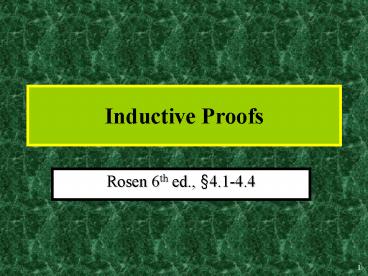Inductive Proofs - PowerPoint PPT Presentation
1 / 16
Title:
Inductive Proofs
Description:
... (P(1) P(2)) (P(k 1) P(k)) (b) Using hypothetical syllogism k-1 times we have P(0) P(k) (c) P(0) and modus ... – PowerPoint PPT presentation
Number of Views:80
Avg rating:3.0/5.0
Title: Inductive Proofs
1
Inductive Proofs
- Rosen 6th ed., 4.1-4.4
2
Mathematical Induction
- A powerful, rigorous technique for proving that a
predicate P(n) is true for every natural number
n, no matter how large. - Based on a predicate-logic inference rule
- P(0)?n?0 (P(n)?P(n1))??n?0 P(n)
3
Outline of an Inductive Proof
- Want to prove ?n P(n)
- Base case (or basis step) Prove P(0).
- Inductive step Prove ?n P(n)?P(n1).
- e.g. use a direct proof
- Let n?N, assume P(n). (inductive hypothesis)
- Under this assumption, prove P(n1).
- Inductive inference rule then gives ?n P(n).
4
Induction Example
- Prove that
5
Another Induction Example
- Prove that ? , nlt2n. Let P(n)(nlt2n)
- Base case P(0)(0lt20)(0lt1)T.
- Inductive step For prove P(n)?P(n1).
- Assuming nlt2n, prove n1 lt 2n1.
- Note n 1 lt 2n 1 (by inductive hypothesis)
lt 2n 2n (because 1lt22?20?2?2n-1 2n)
2n1 - So n 1 lt 2n1, and were done.
6
Validity of Induction
- Prove if ?n?0 (P(n)?P(n1)) and P(0),
then ?k?0 P(k) - (a) Given any k?0, ?n?0 (P(n)?P(n1)) implies
- (P(0)?P(1)) ? (P(1)?P(2)) ? ?
(P(k?1)?P(k)) - (b) Using hypothetical syllogism k-1 times we
have - P(0)?P(k)
- (c) P(0) and modus ponens gives P(k).
- Thus ?k?0 P(k).
7
Generalizing Induction
- Can also be used to prove ?n?c P(n) for a given
constant c?Z, where maybe c?0, then - Base case prove P(c) rather than P(0)
- The inductive step is to prove
- ?n?c (P(n)?P(n1)).
8
Induction Example
- Prove that the sum of the first n odd positive
integers is n2. That is, prove - Proof by induction.
- Base case Let n1. The sum of the first 1 odd
positive integer is 1 which equals 12.(Cont)
P(n)
9
Example cont.
- Inductive step Prove ?n?1 P(n)?P(n1).
- Let n?1, assume P(n), and prove P(n1).
By inductivehypothesis P(n)
10
Strong Induction
- Characterized by another inference
ruleP(0)?n?0 (?0?k?n P(k)) ? P(n1)??n?0
P(n) - Difference with previous version is that the
inductive step uses the fact that P(k) is true
for all smaller , not just for kn.
P is true in all previous cases
11
Example 1
- Show that every ngt1 can be written as a product
p1p2ps of some series of s prime numbers. Let
P(n)n has that property - Base case n2, let s1, p12.
- Inductive step Let n?2. Assume ?2?k?n P(k).
Consider n1. If prime, let s1, p1n1.Else
n1ab, where 1lta?n and 1ltb?n.Then ap1p2pt and
bq1q2qu. Then n1 p1p2pt q1q2qu, a product
of stu primes.
12
Example 2
- Prove that every amount of postage of 12 cents or
more can be formed using just 4-cent and 5-cent
stamps. - Base case 123(4), 132(4)1(5), 141(4)2(5),
153(5), so ?12?n?15, P(n). - Inductive step Let n?15, assume ?12?k?n P(k).
Note 12?n?3?n, so P(n?3), so add a 4-cent stamp
to get postage for n1.
13
Recursive Definitions
- Recursion defining an object (or function,
algorithm, etc.) in terms of itself - Recursion can be used to define sequences
- Previously sequences were defined using a
specific formula, e.g., an 2n for n 0,1,2,... - This sequence can also be defined by giving the
first term of the sequence, namely a0 1, and a
rule for finding a term of the sequence for the
previous one, namely, an1 2an for n
0,1,2,...
14
Recursive Definitions
- When defining a set recursively, we
- (1) specify the initial elements in a basis step
and - (2) provide a rule for constructing new elements
from those we already have in the recursive step - Examples
15
Recursive Algorithms
- Sometimes we can reduce the solution to the
problem with a particular set of input to the
solution of the same problem with smaller input
values - When such a reduction can be done, the solution
to the original problem can be found with a
sequence of reductions, until the problem has
been reduced to the initial case for which the
solution is known
16
Recursive Algorithms
- An algorithm is called recursive if it solves a
problem by reducing it to an instance of the same
problem with smaller input - Examples ..































